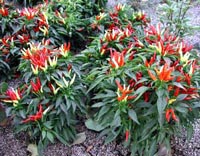Resource Library
Plant of the Week: Pepper, Ornamental
The University of Arkansas System Division of Agriculture does not promote, support or recommend plants featured in "Plant of the Week." Please consult your local Extension office for plants suitable for your region.
Plant of the week
Ornamental Pepper
Latin: Capsicum annuum

As cool weather returns, it’s time for a shift in diet from summer fare to the hearty victuals of wintertime. Chili is high on my list of winter favorites. As anyone who has ever attended a chili cook-off knows, there isn’t much agreement as to what makes the perfect chili. But the chili pepper is universally acknowledged as a required ingredient.
Probably no other garden plant has as much diversity in its gene pool as the hot pepper, Capsicum annuum.
It is a member of the potato family and a native to Central and South America, where it was domesticated almost 10,000 years ago.
Ornamental peppers are compact and grow 12 inches in height and width. Their heavy crops of fire-engine red capsules stand erect like a candle flame. The heat generated by hot peppers comes from a mixture of different capsaicins. These compounds are sensed by the pain sensors in your mouth - the ones that tell you when the coffee is too hot - not by your taste buds. The amount of capsaicin produced is under both genetic and environmental control. A tormented breeder can do wonders to turn up the heat, but droughts and high average night temperatures also increase the capsaicin level.
Plant breeders looking for the perfect ornamental pepper usually pander to the wimps among us and select from low heat sorts. Chilly Chili is a 2002 All-America Annual Selection winner that is available for purchase now.
Chilly Chili is a compact ornamental pepper that produces a heavy load of mild, two-inch long, erect chilies. The chilies start green, and then change through chartreuse and orange on their way to a deep, waxy red. Because the plant is indeterminate in its growth habit, it has fruit in all stages of development and gives a handsome blend of colors throughout the summer and fall. The indeterminate growth habit means that plants will have fruit on display from July until frost, with the plant getting more grand as the season progresses.
When Columbus glided into Hispaniola in 1492 looking for spices and a shortcut to Cathay, he found the natives growing a plant that put the peppercorn of the Indian continent to shame for its heat and taste. But lacking suitable verbiage to describe the fire generated by the new herb, the Spaniards chose to call it by the familiar name of pimiento, or pepper. The Spanish who interbred with the native population and settled Mexico called the plant chilli.
The culinary roots of chili are uncertain, but it seems likely that it may have spread to the United States from the Mexican laundry ladies who washed shirts for soldiers fighting in the border wars of the1830's and 40's. In addition to their laundry detail, they brewed a chili-laden concoction affectionately called son-of-a-bitch stew. After Texas became a state, the chuck wagons on the cattle drives helped spread its fame.
In 1892 Willie Gebhardt from New Braunfels, Texas, perfected chili powder made from dried chilies, oregano, cumin and garlic. With the basic ingredient in hand, Californians were free to make their chili using avocados and olives while old salts in Maine used shell fish and beans to brew a bowl of winter’s finest food.
The ornamental peppers are grown both as bedding plants for front-of-the-border display or as a pot plant for table decoration. In the garden it does best in sunny, fertile soils with just average care. As a pot plant it is usually purchased with a full head of fruit and will remain effective for six weeks with even minimal care. Pests and diseases don’t bother the plant.
By: Gerald Klingaman, retired
Extension Horticulturist - Ornamentals
Extension News - October 12, 2001
The University of Arkansas System Division of Agriculture does not maintain lists of retail outlets where these plants can be purchased. Please check your local nursery or other retail outlets to ask about the availability of these plants for your growing area.